25 Best Temples to Visit in Kyoto
Check out the Best Temples to Visit in Kyoto. Kyoto, Japan is renowned for its rich cultural heritage and historic temples. There are many temples and shrines in Kyoto, and it can be overwhelming to decide which ones to visit during your trip. To help plan your Kyoto temple pilgrimage, we’ve provided a list of the best temples to visit in Kyoto:
Kiyomizu-dera Temple
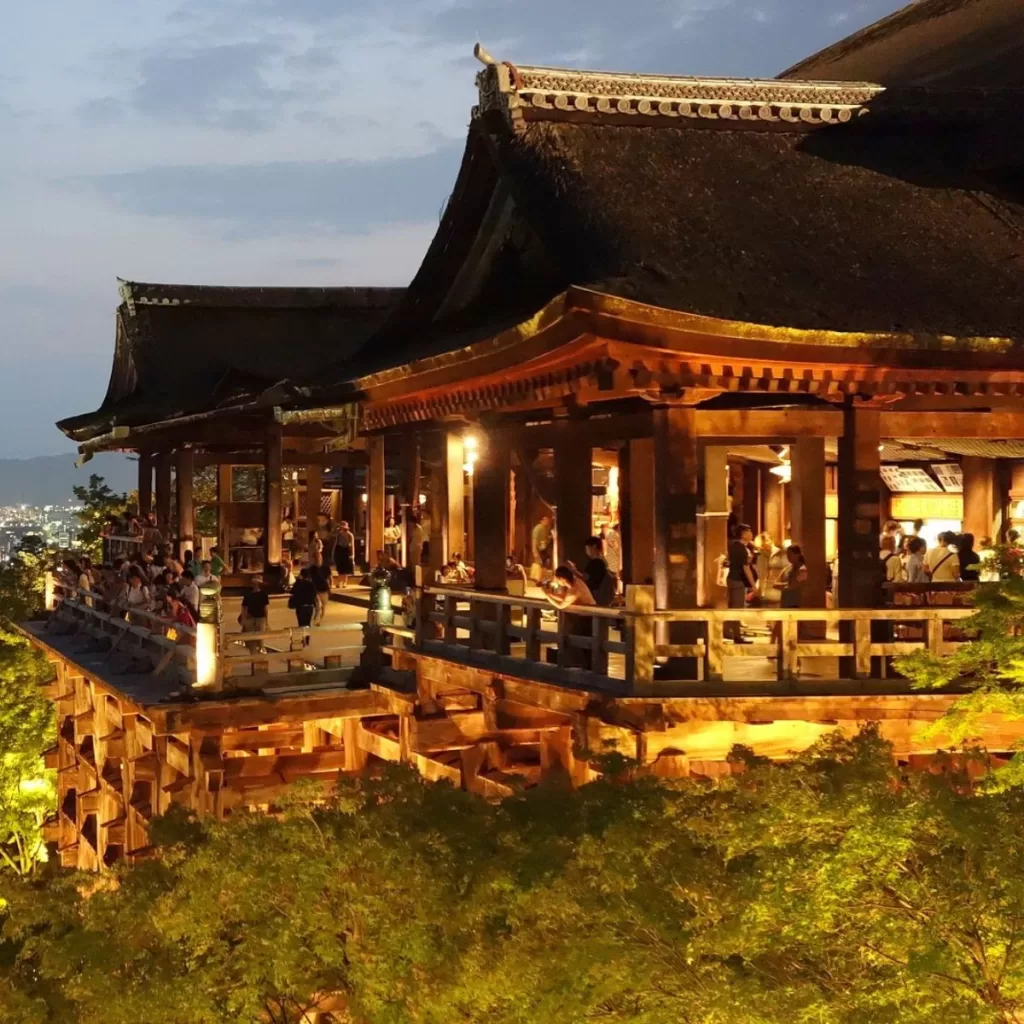
One of the best temples in Kyoto is Kiyomizu-dera. Perched on Mt. Otowa hillside, Kiyomizu-dera is one of Eastern Kyoto’s most popular temples. Founded in 780, its iconic wooden stage offers panoramic views of the city. The temple is surrounded by cherry blossoms in spring and autumn leaves in fall. A UNESCO World Heritage Site, it’s a must-see.
One of the main highlights of Kiyomizu-dera is its magnificent wooden stage, which stands out as a testament to traditional Japanese craftsmanship. From this elevated vantage point, you can admire the panoramic view of Kyoto and the picturesque cherry blossom trees during springtime. It’s truly a sight to behold and a popular spot for photographers and visitors alike.
Kiyomizu-dera Temple offers not only a visual feast but also a chance to immerse yourself in Japanese culture and spirituality. Take your time to explore the temple’s serene atmosphere, appreciate the intricate details of the architecture, and enjoy the tranquility that comes with being surrounded by nature. It’s an experience that truly captures the essence of Kyoto’s beauty and heritage.
Kinkaku-ji (Golden Pavilion)
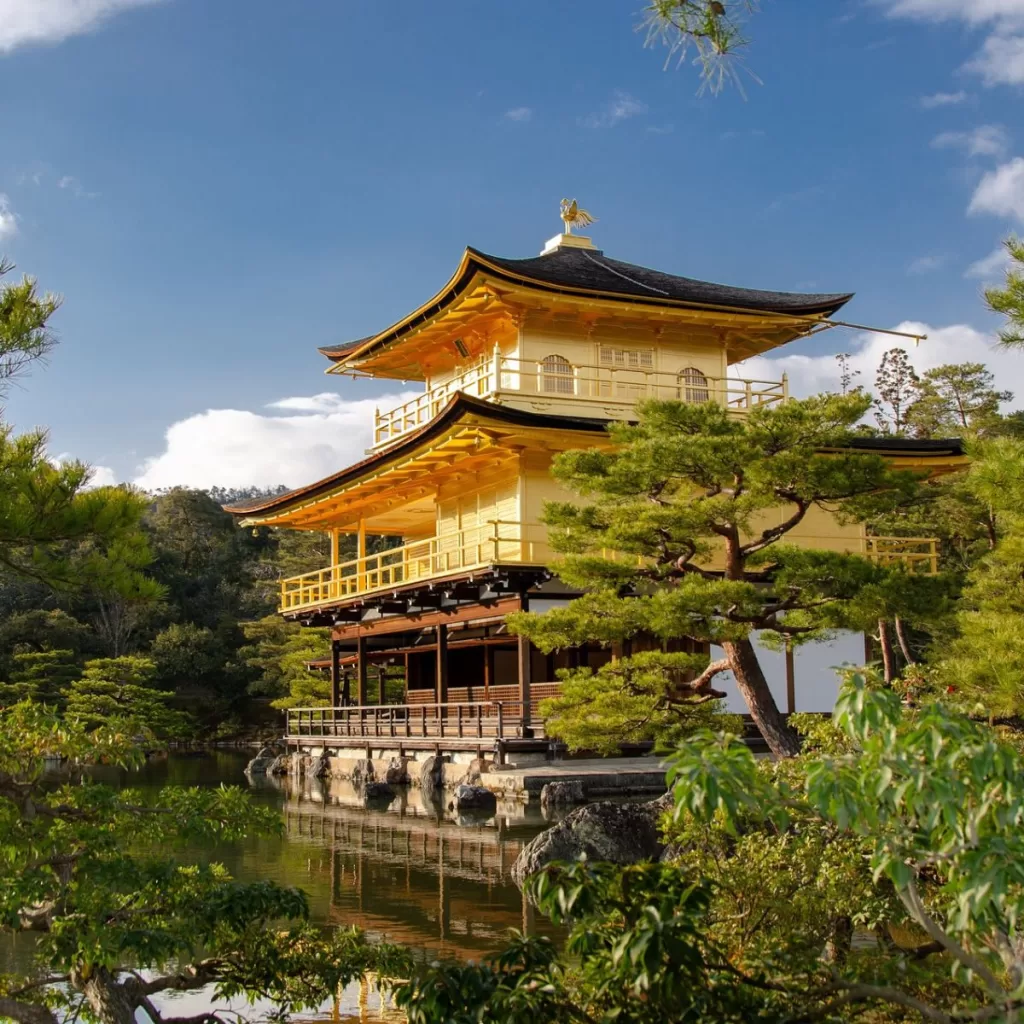
Kinkaku-ji, known as the Golden Pavillion, is a Zen Buddhist temple. It is Kyoto’s most famous Zen temple, the top two floors of the Golden Pavilion are covered in gold leaf. Reflecting on the pond’s surface, it is one of Japan’s most photographed sites. The temple grounds have strolling paths through pine trees and beautiful gardens.
The main highlight of Kinkaku-ji is, of course, the stunning golden facade that glistens in the sunlight. Admire the meticulous craftsmanship and intricate details that adorn the pavilion, making it a true architectural masterpiece. It’s no wonder that Kinkaku-ji has become a symbol of Kyoto’s cultural heritage.
Surrounded by meticulously manicured gardens and lush greenery, Kinkaku-ji offers a peaceful and serene atmosphere that is perfect for meditation and reflection. Take a leisurely stroll through the gardens, breathe in the fresh air, and let the tranquility of the surroundings wash over you. It’s definitely one of the most beautiful temples in Kyoto.
Ginkaku-ji (Silver Pavilion)
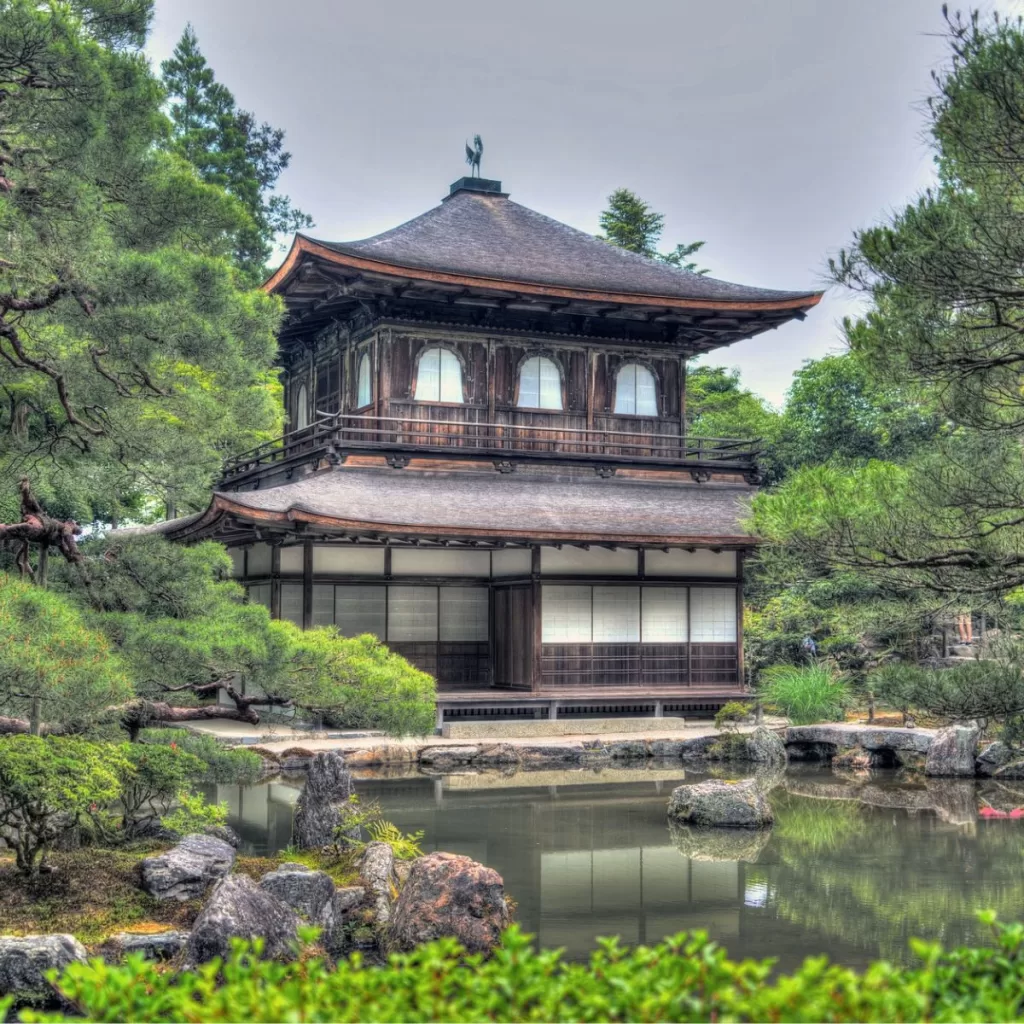
Modeled after the Golden Pavilion, the Silver Pavilion’s minimalist architecture and tranquil moss garden create a simple elegance.
This tranquil and serene destination is famous for its minimalist design and stunning architecture. As you enter the temple grounds, you’ll be greeted by the peaceful atmosphere and the beauty of the surrounding gardens.
Ginkaku-ji is a true masterpiece that embodies the craftsmanship of Japanese architecture. The temple’s elegant silver exterior contrasts with the lush greenery around it, creating a serene and calming ambiance. Explore the temple’s interior, adorned with exquisite artworks and traditional elements, offering a glimpse into Japan’s rich cultural heritage. It’s a must see temple.
Nanzen-ji
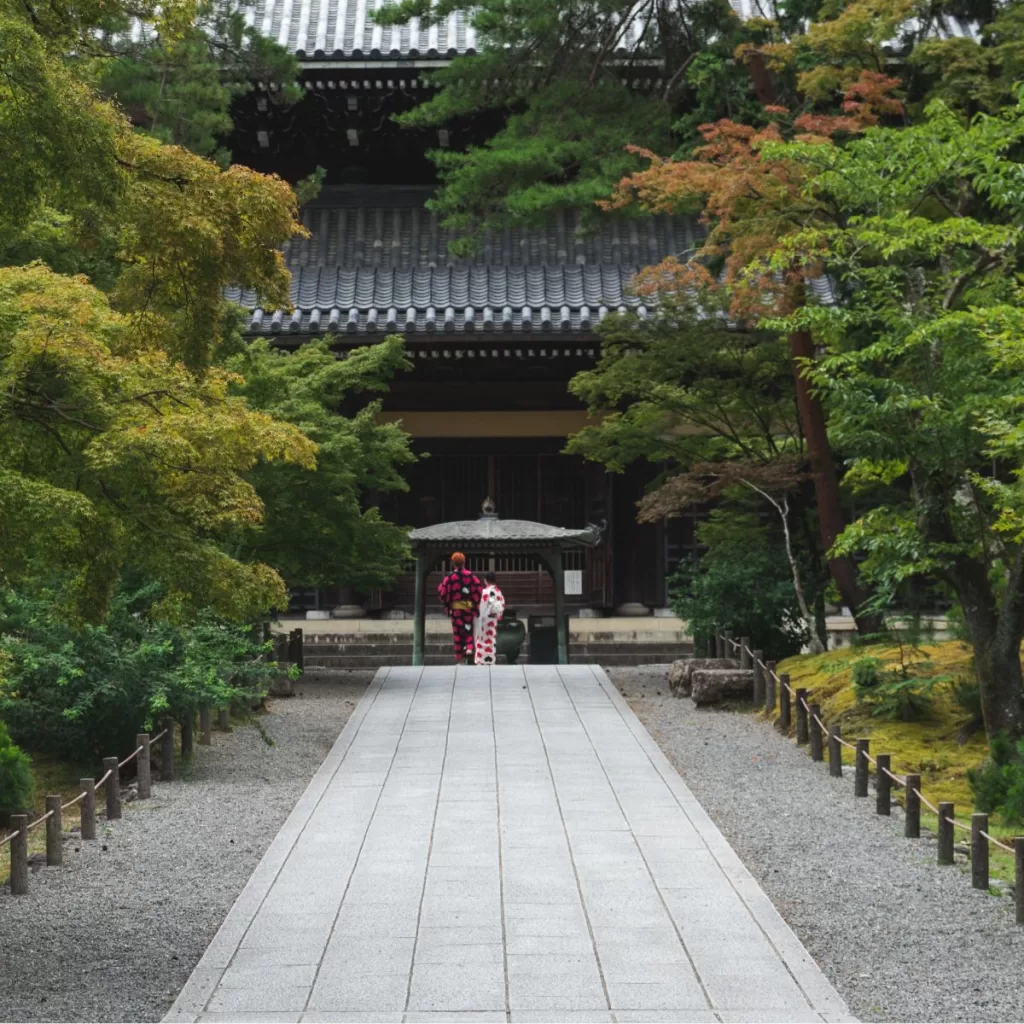
Founded in 1291 during Japan’s medieval period, Nanzen-ji is one of the most important Zen temples in Kyoto. The temple grounds harbor scenic ponds, Japanese maples, and the iconic two-story Sanmon gate dwarfed by surrounding forest.
The main hall, known as the Hojo, showcases traditional Japanese architecture with its elegant design and beautifully painted sliding doors. Take a moment to admire the intricate details of the artwork and immerse yourself in the Zen ambiance.
One of the highlights of Nanzen-ji is its expansive temple complex, which includes picturesque gardens, serene ponds, and tranquil walking paths. Explore the beautiful Nanzen-ji Sanmon gate, the largest wooden gate in Japan, and climb to its top for stunning panoramic views of the surroundings. It’s one of the most famous temples in Kyoto.
Tenryu-ji Temple
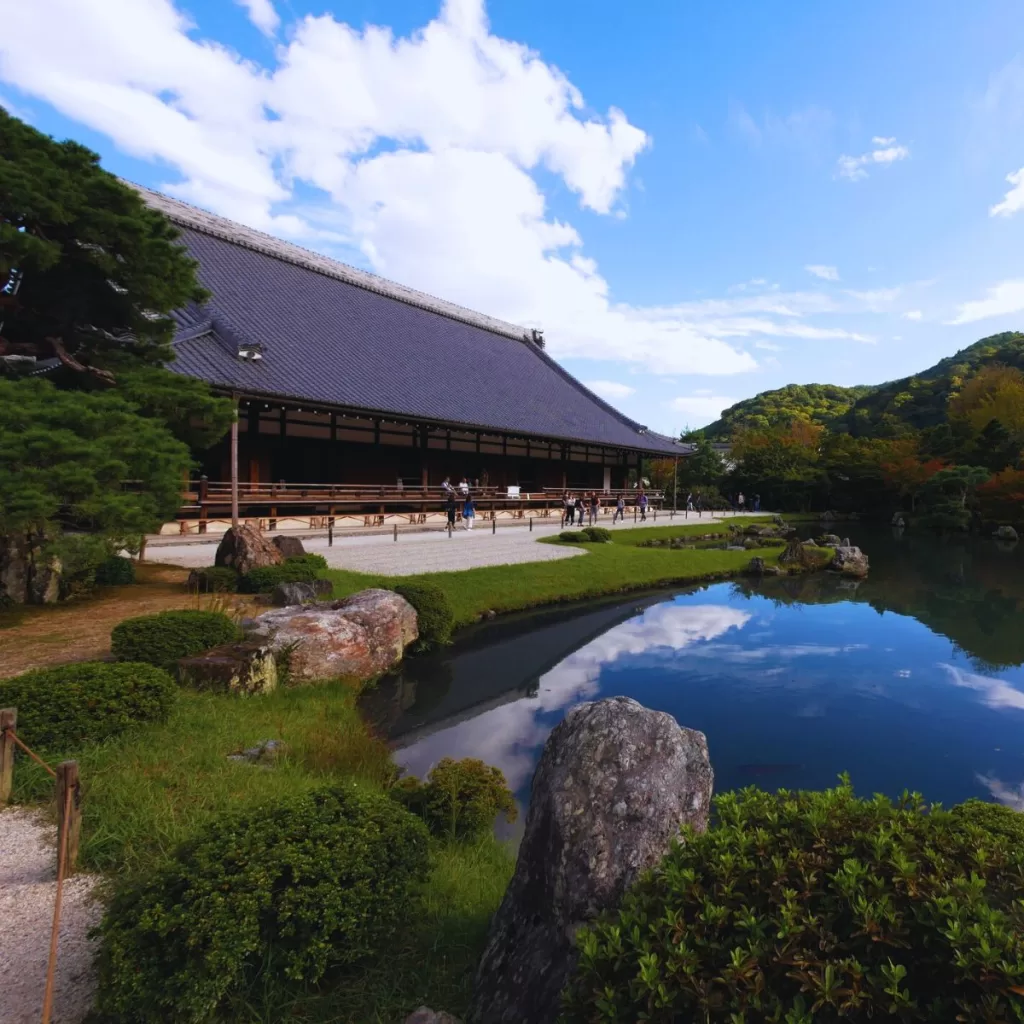
A UNESCO World Heritage Site, Tenryū-ji showcases one of Kyoto’s most breathtaking landscape gardens with gorgeous autumn foliage. Built in 1339, it is one of Kyoto’s five great Zen temples and offers a peaceful environment for meditation.
One of the main attractions of Tenryu-ji is its stunning Sogenchi Garden, considered one of the finest examples of Japanese Zen gardens. Take a leisurely stroll along the paths, appreciating the meticulously designed landscapes, centuries-old trees, and peaceful pond. The garden’s harmonious composition, designed to evoke a sense of tranquility, provides a serene escape from the busy city life.
The temple’s main hall, Hojo, is another remarkable feature of Tenryu-ji. Adorned with intricate woodwork and stunning paintings, it houses important cultural artifacts and offers a glimpse into the rich history of the temple. Step inside and feel the sacredness and serenity that permeates the hall.
Tofuku-ji Temple
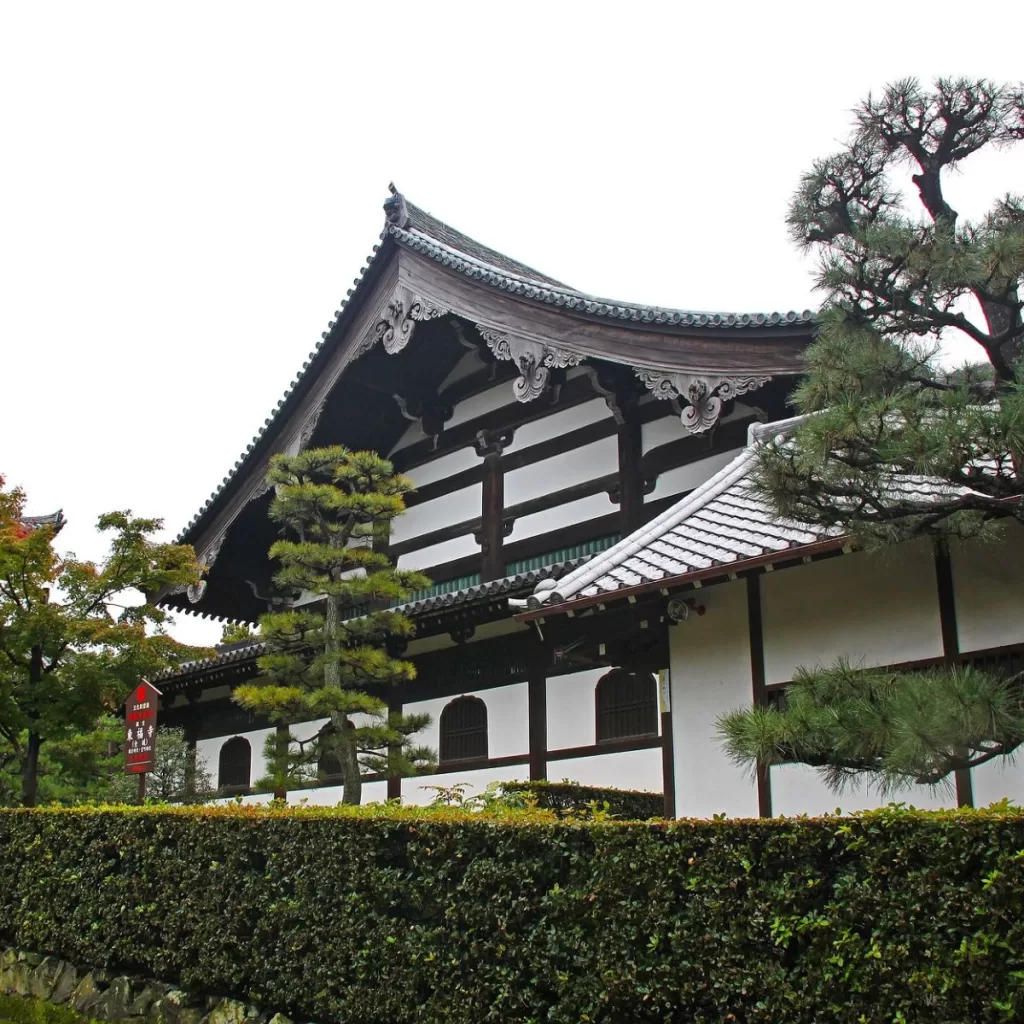
Home to oldest Zen temple in Kyoto, Tofuku-ji’s maples emblazoned the temple with red leaves in November. Founded in 1236, Tofuku-ji also has the oldest sanmon gate in Japan and 22 sub-temples.
With its serene ambiance and stunning architecture, Tofuku-ji offers a memorable experience for visitors seeking tranquility and cultural immersion. As you enter the temple grounds, you’ll be captivated by the beauty of its expansive gardens, traditional structures, and rich historical significance.
One of the main highlights of Tofuku-ji is its iconic Tsutenkyo Bridge, a long wooden bridge that spans across a vibrant valley of maple trees. During the autumn season, this bridge becomes a captivating showcase of vibrant red and orange foliage, drawing visitors from near and far. Walking across the bridge allows for breathtaking views of the stunning autumn colors, creating a picturesque and unforgettable experience.
Tofuku-ji is also renowned for its well-maintained Zen gardens, featuring meticulously raked gravel, carefully placed stones, and serene greenery. These gardens offer a peaceful retreat where visitors can take a moment to relax, meditate, and appreciate the simplicity and beauty of nature.
Nishi Hongan-ji Temple
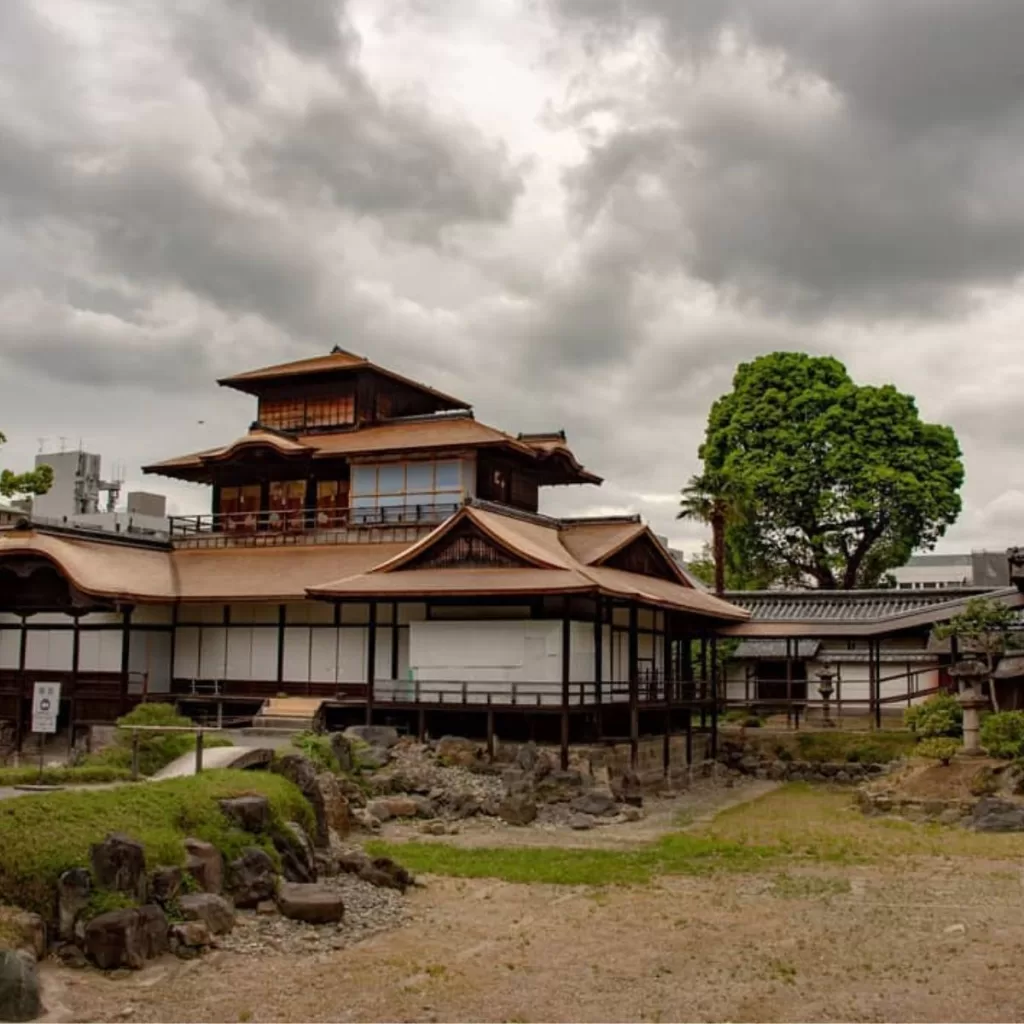
This historic temple invites visitors to experience its grandeur, explore its rich cultural heritage, and immerse themselves in the peaceful atmosphere.
As you step into Nishi Hongan-ji Temple, you’ll be greeted by its impressive architecture and a sense of tranquility that envelops the entire complex.
One of the main attractions of Nishi Hongan-ji Temple is its magnificent main hall, known as Goeido. This majestic structure stands as a testament to the rich history and craftsmanship of Japan.
Byōdō-in

Built as a temple in 1052, Byōdō-in’s Phoenix Hall houses a gilded Amida Buddha. This Tendai sect temple lies in the countryside outside Kyoto. The temple also overlooks a pond designed to resemble the Buddhist Pure Land paradise, creating heavenly scenery.
This iconic temple is renowned for its stunning architecture and serene surroundings, offering visitors a truly enchanting experience. As you enter the temple grounds, you’ll be transported back in time to the 11th century, where you can immerse yourself in the rich history and cultural significance of this architectural gem.
One of the main attractions of Byōdō-in is its iconic Phoenix Hall, also known as Amida Hall. This elegant and graceful structure features a captivating design with its curved roof and intricate wooden carvings. The hall is adorned with beautiful statues and artworks that reflect the artistry and craftsmanship of the Heian period. Step inside the hall and experience the peacefulness and tranquility that emanates from its sacred interior.
Daigo-ji
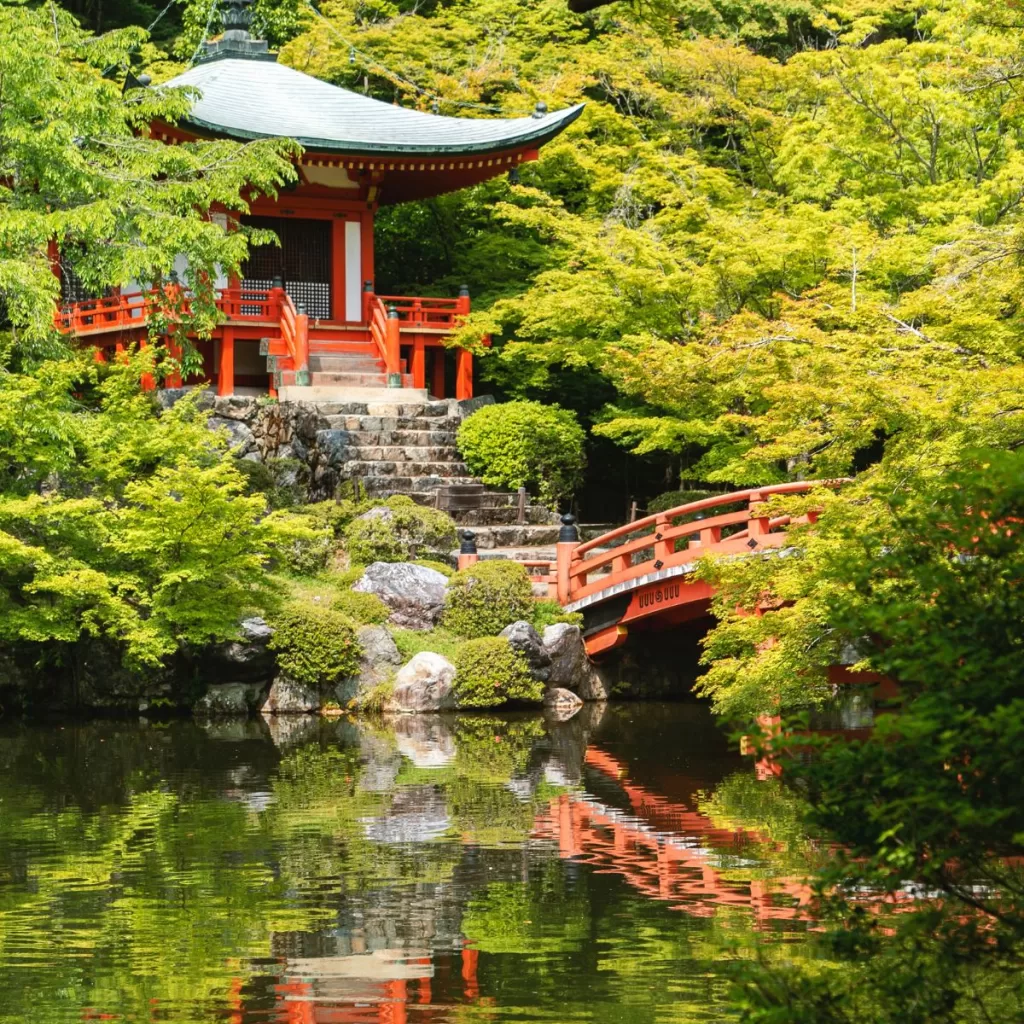
Daigo-ji’s expansive temple complex founded in 874 contains some of Japan’s most treasured buildings. In Southern Kyoto, it blends Shingon Buddhist and samurai influence through its vivid colors, detailed artwork, and landscape.
One of the highlights of Daigo-ji Temple is its five-story pagoda, a towering structure that stands as a symbol of the temple’s rich history and religious significance. Adorned with intricate details and vibrant colors, the pagoda offers a captivating sight and a unique photographic opportunity.
Explore the temple’s vast and breathtaking gardens, including the renowned Sanbo-in Garden and Shimo-Daigo Garden. These meticulously landscaped gardens feature beautifully arranged flowers, tranquil ponds, and winding paths, creating a serene and meditative atmosphere. Take a leisurely stroll through the gardens and let the beauty of nature envelop your senses. It’s one of the most beautiful places to visit in Kyoto.
Ninna-ji

One of Kyoto’s most popular temples for its autumn colors, Ninna-ji is draped in vibrant maple leaves in November. As a head temple of the Omuro school of Shingon Buddhism, it has ornately decorated buildings and rare Buddha sculptures.
This extraordinary temple offers visitors a peaceful sanctuary where they can immerse themselves in a rich blend of history, spirituality, and natural beauty. As you enter the temple grounds, you’ll be greeted by a tranquil atmosphere and a sense of serenity that invites you to explore its many treasures.
Ninna-ji Temple is also known for its connection to the Omuro Cherry Blossom Festival, one of the most celebrated events in Kyoto. During the festival, which usually takes place in early April, visitors can enjoy a spectacular display of cherry blossoms, participate in traditional tea ceremonies, and experience the vibrant cultural performances that take place within the temple grounds.
Kōdai-ji
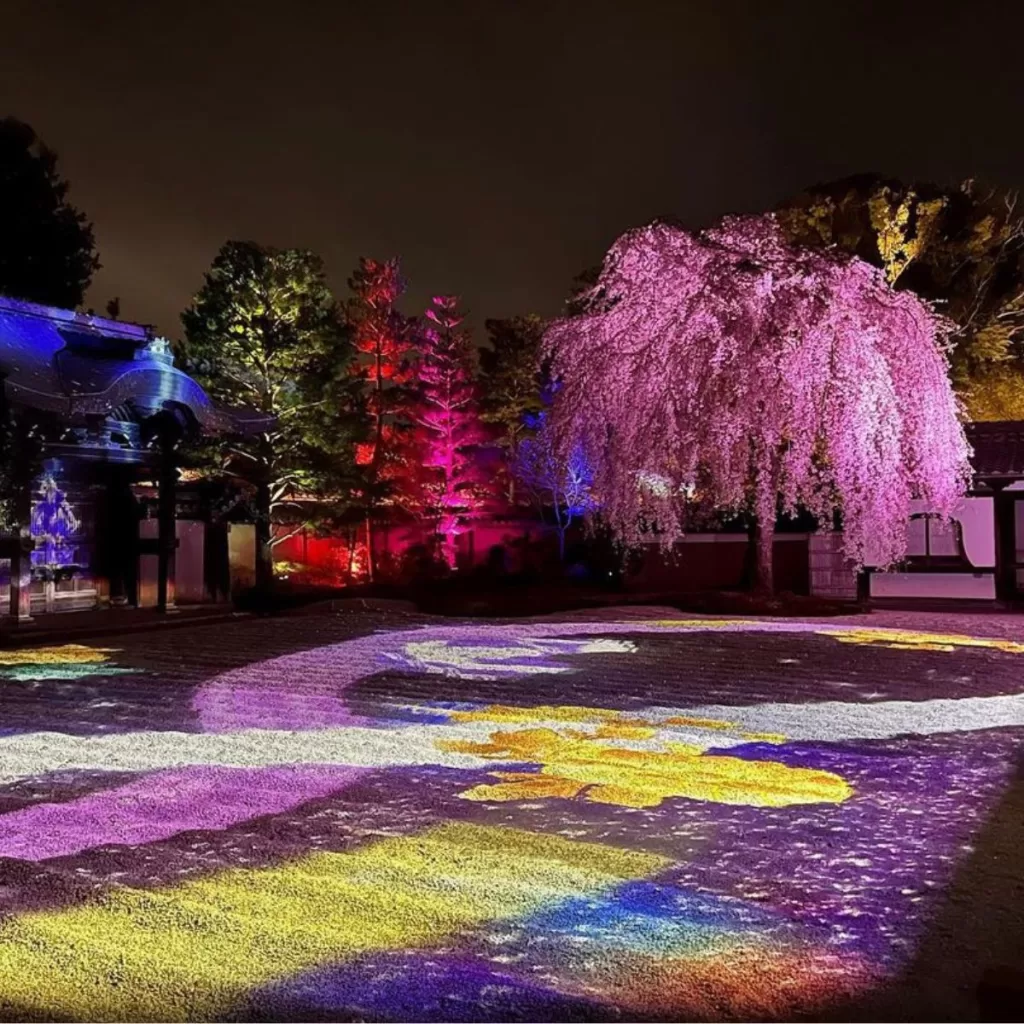
Founded in 1605 by the widow of samurai Toyotomi Hideyoshi, Kōdai-ji has important historical and artistic significance. The temple buildings display classic Japanese aesthetics, while groves and gardens offer scenic strolls.
One of the main attractions of Kōdai-ji Temple is its mesmerizing rock garden, known as the Entoku-in Zen Garden. This meticulously designed garden features carefully placed rocks, raked gravel, and lush moss creating a serene and meditative atmosphere. Take a moment to sit and contemplate the simplicity and harmony of this captivating garden.
Kōdai-ji Temple offers a true escape from the hustle and bustle of everyday life, inviting visitors to immerse themselves in the beauty of Japanese Zen Buddhism and the serenity of its gardens. Whether you’re seeking a peaceful environment for reflection, an appreciation for art and architecture, or a cultural experience, Kōdai-ji Temple is the perfect destination to find solace and inspiration.
Chion-in Temple
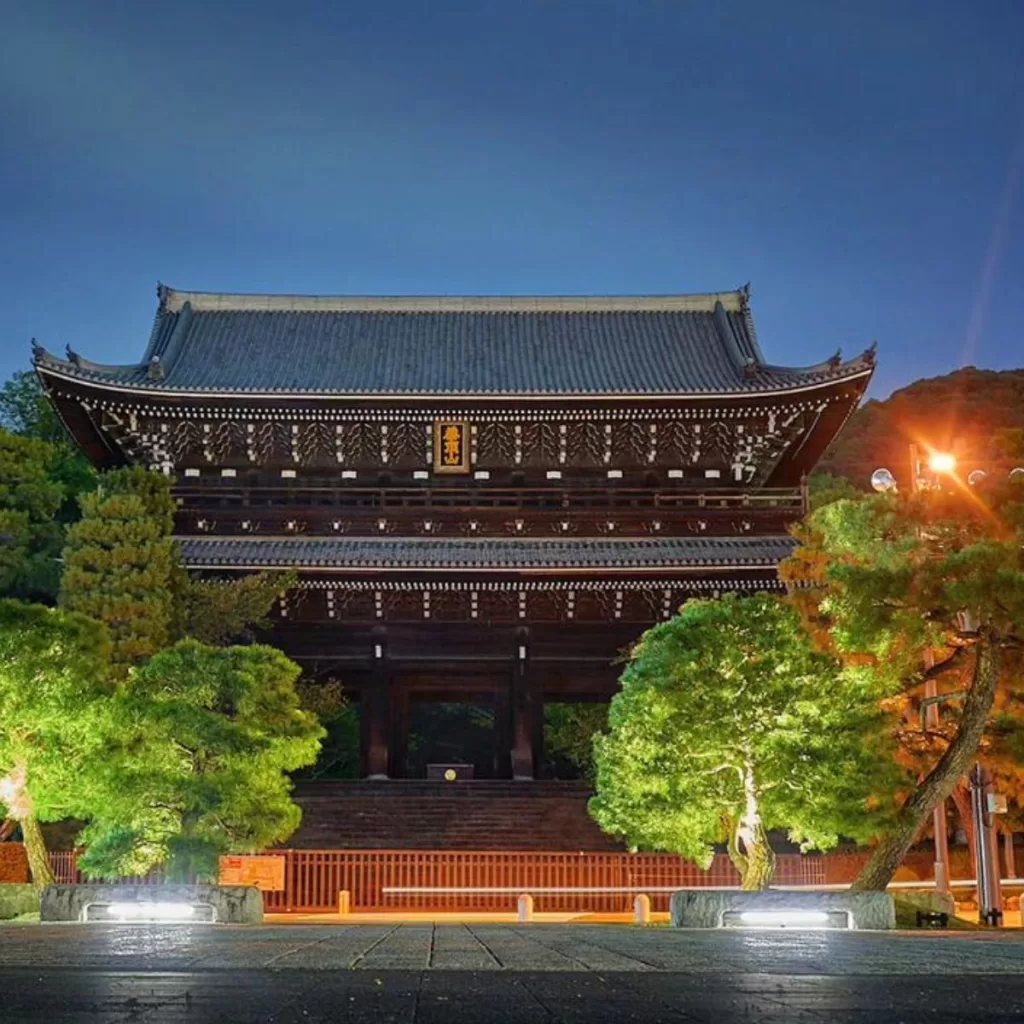
Chion-in Temple is one of the grandest temples in Kyoto. The headquarters of Jōdo Buddhism, Chion-in’s colossal size matches its religious prominence. The temple contains Japan’s largest wooden temple gates along with spacious temple grounds and gardens.
This remarkable temple invites visitors to immerse themselves in a world of spirituality, architectural grandeur, and cultural heritage. As you enter the temple grounds, you’ll be captivated by its grand entrance gate and the serene atmosphere that permeates the air.
Chion-in Temple is home to some of the largest temple buildings in Japan, including the massive Sanmon gate, which stands as an impressive testament to Japanese architecture. As you pass through this monumental gate, you’ll feel a sense of awe and reverence for the history and traditions that unfold within the temple.
Shoren-in
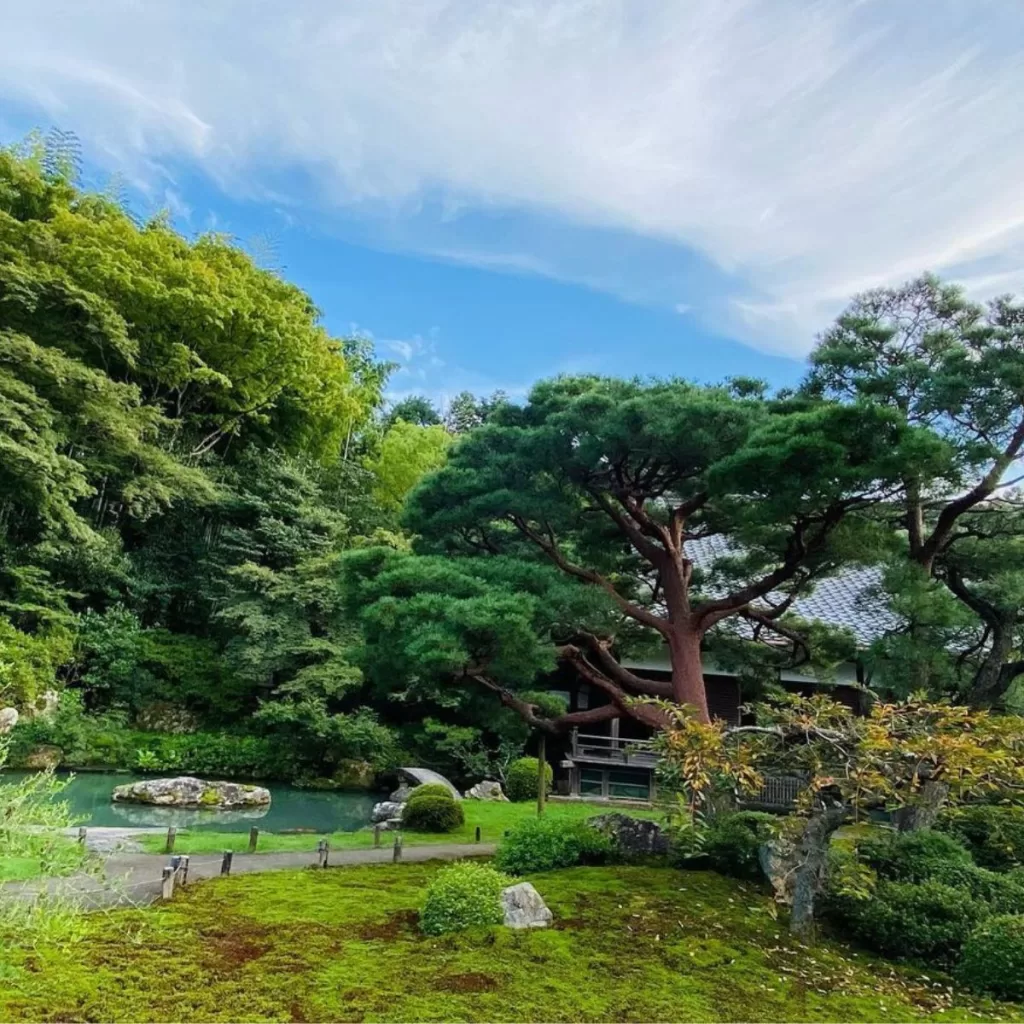
Nestled in Kyoto’s hills, Shoren-in exudes tranquility in its architecture and sprawling temple grounds. The temple offers lodging to experience morning rituals. Springtime sees lush pink cherry blossoms against vibrant green moss.
Shoren-in Temple also offers visitors the chance to experience traditional tea ceremonies, a true embodiment of Japanese culture and hospitality. Participate in this age-old ritual and savor the delicate flavors of matcha tea while enjoying the serene surroundings of the temple. It’s a unique opportunity to immerse yourself in Japanese traditions and deepen your understanding of the local culture.
Shoren-in Temple is a haven for those seeking respite from the bustling city, where they can find solace in the serenity of nature and culture. Your stay in Kyoto will be worth it if you visit this temple.
Daitoku-ji
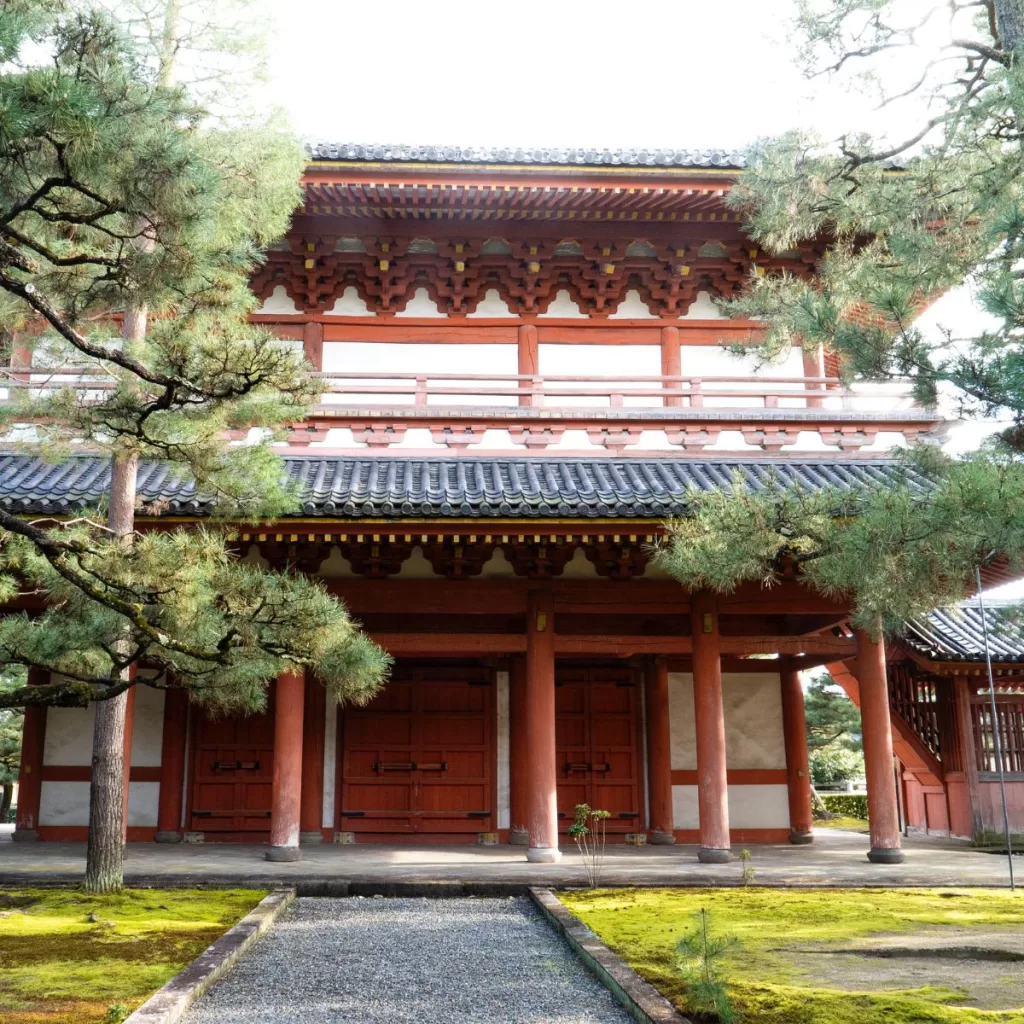
A compound rather than single temple, Daitoku-ji is a walled-in complex of 22 sub-temples, ponds, rock gardens, and bamboo groves to explore. Founded in 1319, it is the epitome of Zen architecture.
Daitoku-ji Temple is home to an impressive collection of sub-temples, each offering a unique experience and architectural beauty. Take the time to wander through the different gardens and halls, and admire the simplicity and elegance of the Zen aesthetic. The intricate rock gardens, lush greenery, and traditional tea houses create a harmonious and meditative environment.
One of the highlights of Daitoku-ji Temple is the Daisen-in sub-temple, renowned for its iconic karesansui (dry rock) garden. This Zen garden features carefully raked gravel and beautifully arranged rocks, designed to symbolize mountains and rivers. Take a moment to sit in contemplation and let the peacefulness of the garden wash over you.
Eikan-dō

Eikan-dō shines in the fall with vibrant yellow and red maple leaves surrounding its temple buildings. Its famous painting of Mikaeri Amida, a Buddha glancing backwards, sets it apart from other Kyoto temples.
Eikan-dō Temple is renowned for its stunning autumn foliage, offering a kaleidoscope of colors that captivate the senses. During the autumn season, the temple’s gardens come alive with vibrant red, orange, and yellow hues, creating a picturesque backdrop for your visit. It’s a truly magical experience that should not be missed.
One of the must-see attractions at Eikan-dō Temple is the Amida Hall, which houses a magnificent statue of Buddha surrounded by intricate paintings and delicate lanterns. Step inside this hall and feel a deep sense of reverence as you soak in the spiritual atmosphere. It’s a place for reflection, meditation, and contemplation.
Entoku-in
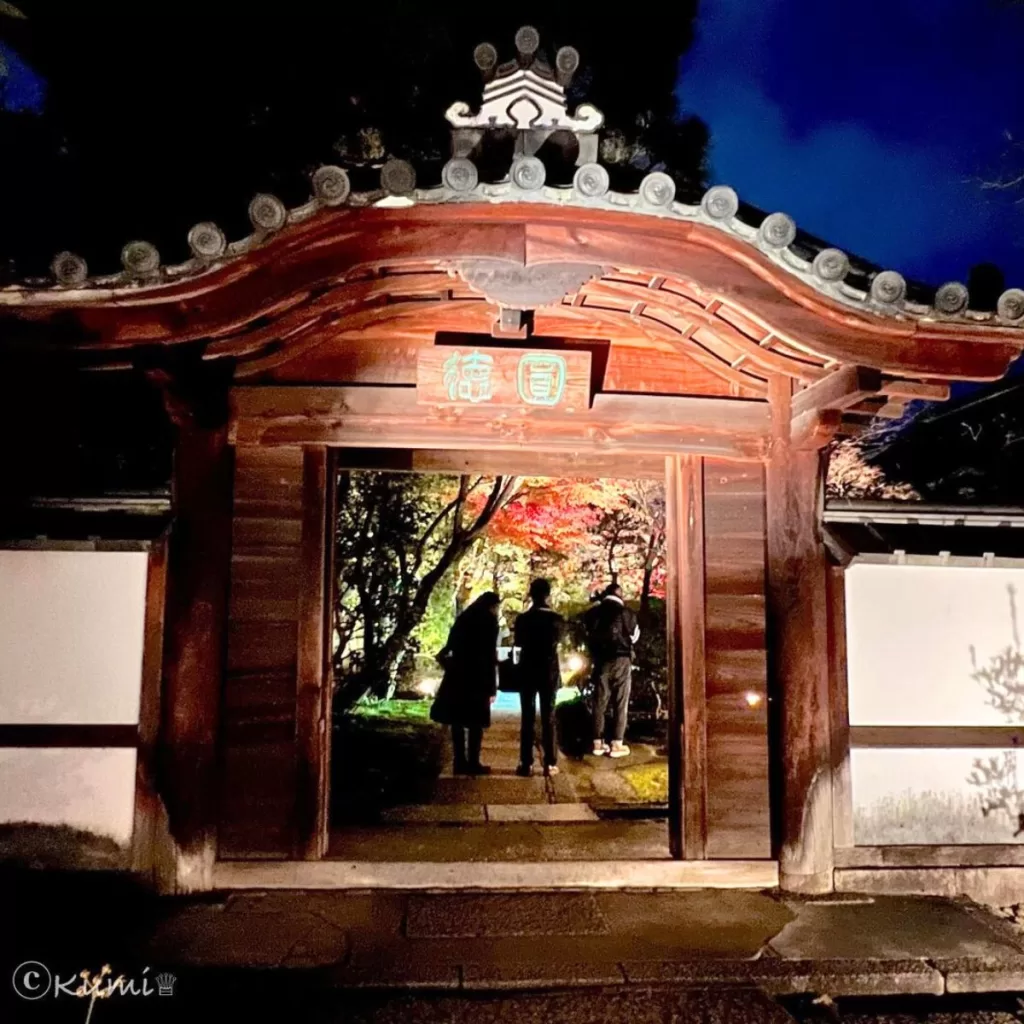
Tucked within Arashiyama’s bamboo groves, Entoku-in honors the life of samurai Hideyoshi Toyotomi while offering a serene escape. Surrounded by nature with pond views, Entoku-in displays prized art.
This peaceful Buddhist temple offers visitors a unique and serene experience, where they can appreciate the simplicity of Japanese aesthetics and find solace amidst the bustling city. As you enter the temple grounds, you’ll be enveloped by a sense of tranquility and a serene ambiance that invites you to explore its sacred spaces.
Don’t miss the opportunity to experience a traditional tea ceremony at Entoku-in Temple. Participate in this centuries-old ritual and savor the delicate flavors of matcha tea while immersing yourself in the serenity of the temple surroundings. The tea ceremony offers a unique glimpse into Japanese culture and provides an intimate and memorable experience.
Gio-ji
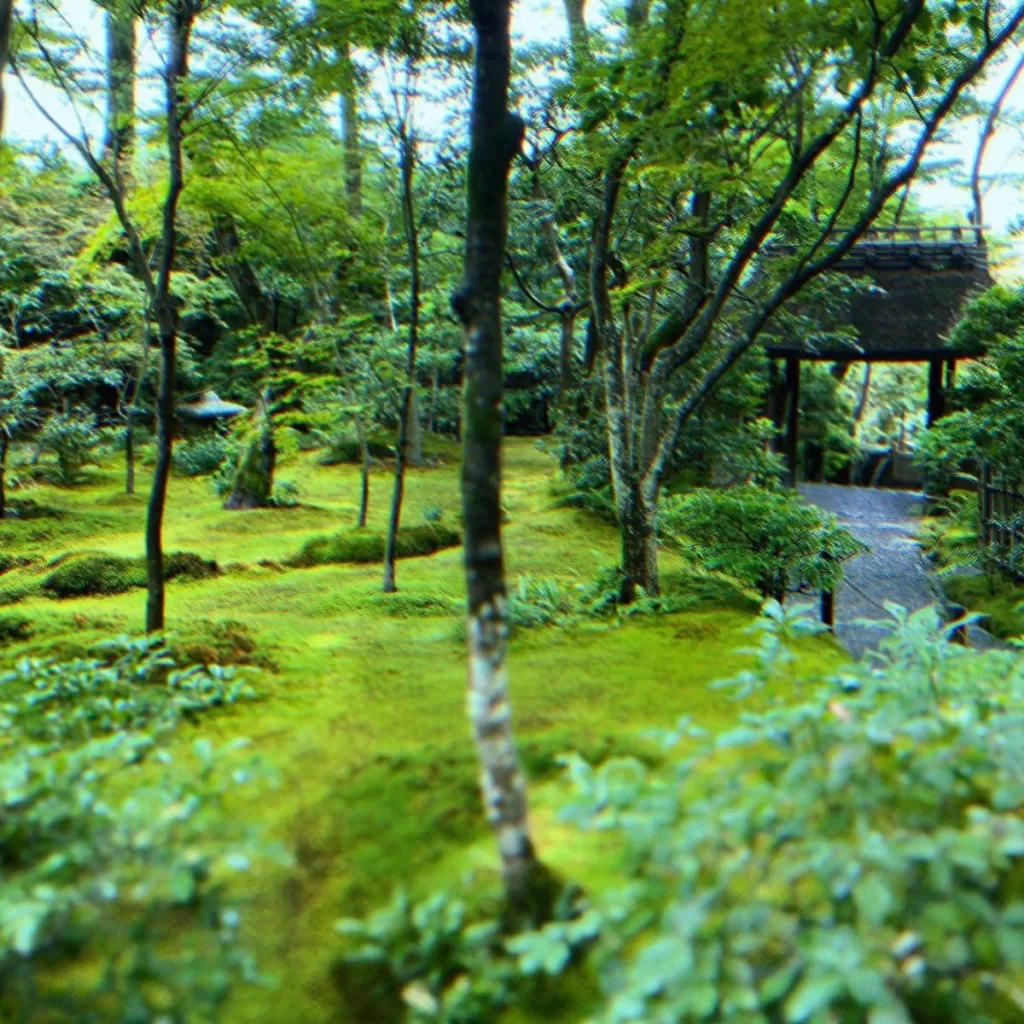
Gio-ji’s thatched roof moss temple and picturesque landscape encapsulate the beauty of temple life in harmony with nature. Located off the beaten path, it provides a quiet, meditative environment surrounded by maple trees.
A hidden gem tucked away in the scenic mountains of Kyoto, Japan. This tranquil Buddhist temple offers visitors a serene and picturesque retreat, where they can immerse themselves in the beauty of nature and the tranquility of the temple grounds. As you step into Gio-ji Temple, you’ll be greeted by a sense of calmness and a breathtaking view of the lush green moss that blankets the entire area.
Gio-ji Temple is known for its mesmerizing moss garden, which creates a serene and mystical atmosphere. The temple grounds feature delicate moss-covered stone pathways, accompanied by a canopy of towering bamboo trees. It’s a truly enchanting spectacle that transports visitors to a world of tranquility and natural beauty.
Adashino Nenbutsu-ji
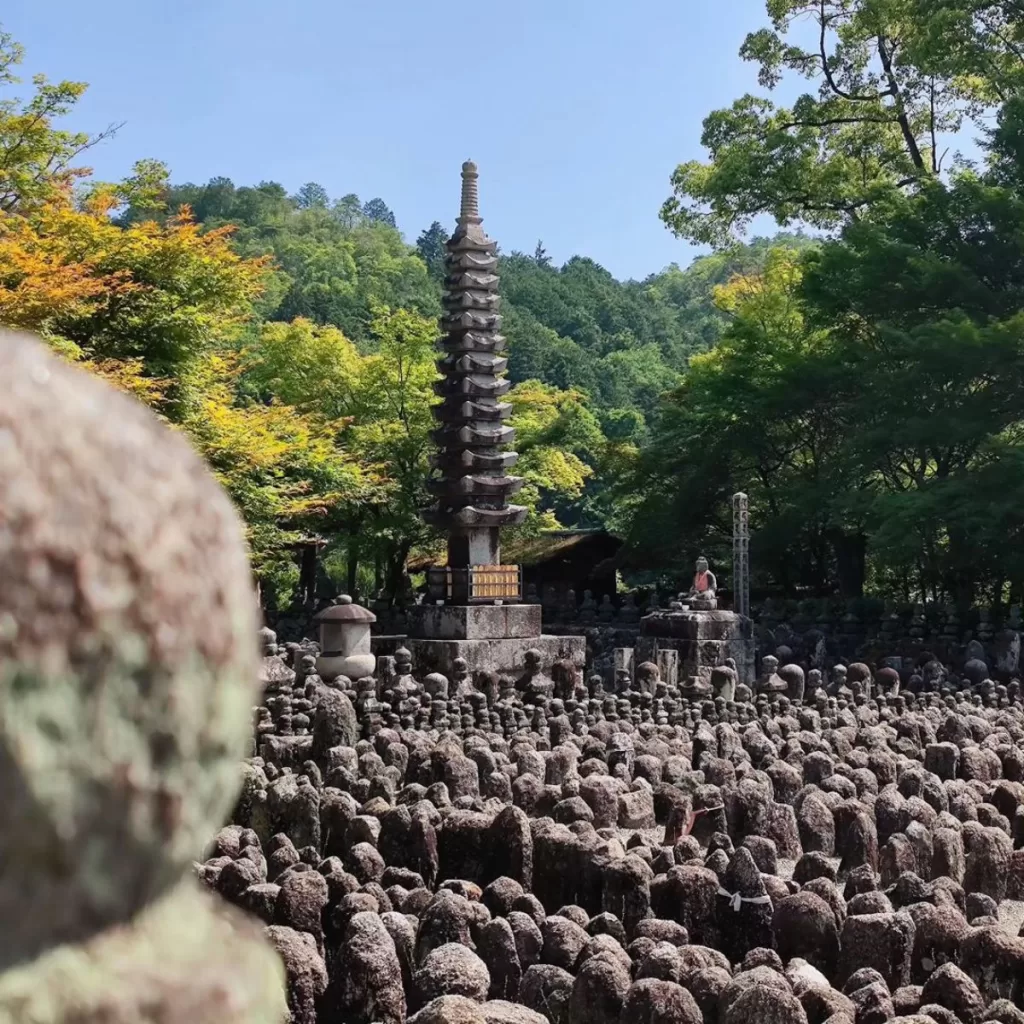
Home to around 8000 stone statues of rakan, or Buddha’s disciples, Adashino Nenbutsu-ji is mysteriously captivating. The temple Tell a story through its stone Buddhist effigies, now worn with age and moss.
One of the main attractions at Adashino Nenbutsu-ji Temple is the impressive collection of stone statues known as the Nenbutsu-ji Jizo. These statues, each representing a departed soul, are scattered throughout the temple grounds, creating a poignant and reflective atmosphere. Take a moment to respectfully observe these statues and learn about the rich symbolism behind them.
Another notable feature of Adashino Nenbutsu-ji Temple is the serene bamboo grove that lines the paths within the temple grounds. As you walk through the tranquil bamboo forest, listen to the gentle rustling of the leaves and feel a sense of calmness envelope you. The bamboo grove offers a peaceful and immersive experience, allowing visitors to escape from the noise and busyness of everyday life.
Kennin-ji
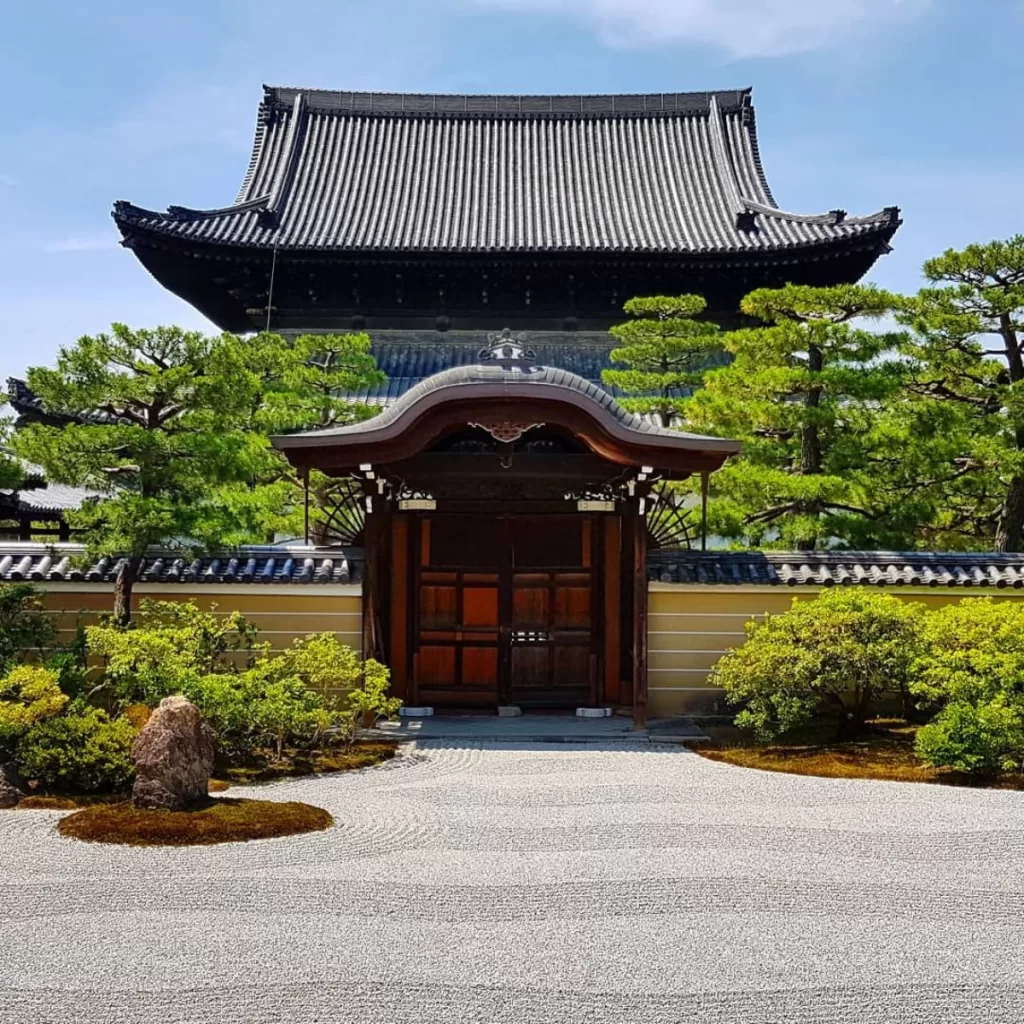
Kyoto’s oldest Zen temple, Kennin-ji was founded in 1202. The temple boasts exquisite frescoes, dragon artwork built without nails, and Japan’s oldest tsukubai water basin.
This ancient Kyoto temple offers visitors a captivating combination of cultural heritage, stunning artwork, and a tranquil atmosphere. As you step into Kennin-ji Temple, you’ll be transported to a world of serenity and beauty, where you can immerse yourself in the rich history and profound spirituality of this revered place.
One of the main highlights of Kennin-ji Temple is its magnificent ceiling painting, known as the “Wind and Thunder Gods.” This breathtaking artwork depicts the dynamic figures of two powerful guardian deities, creating a sense of awe and reverence. Take a moment to gaze up at this masterpiece and let its vibrant colors and intricate details captivate your imagination. This temple is definitely worth a visit.
Ryoanji
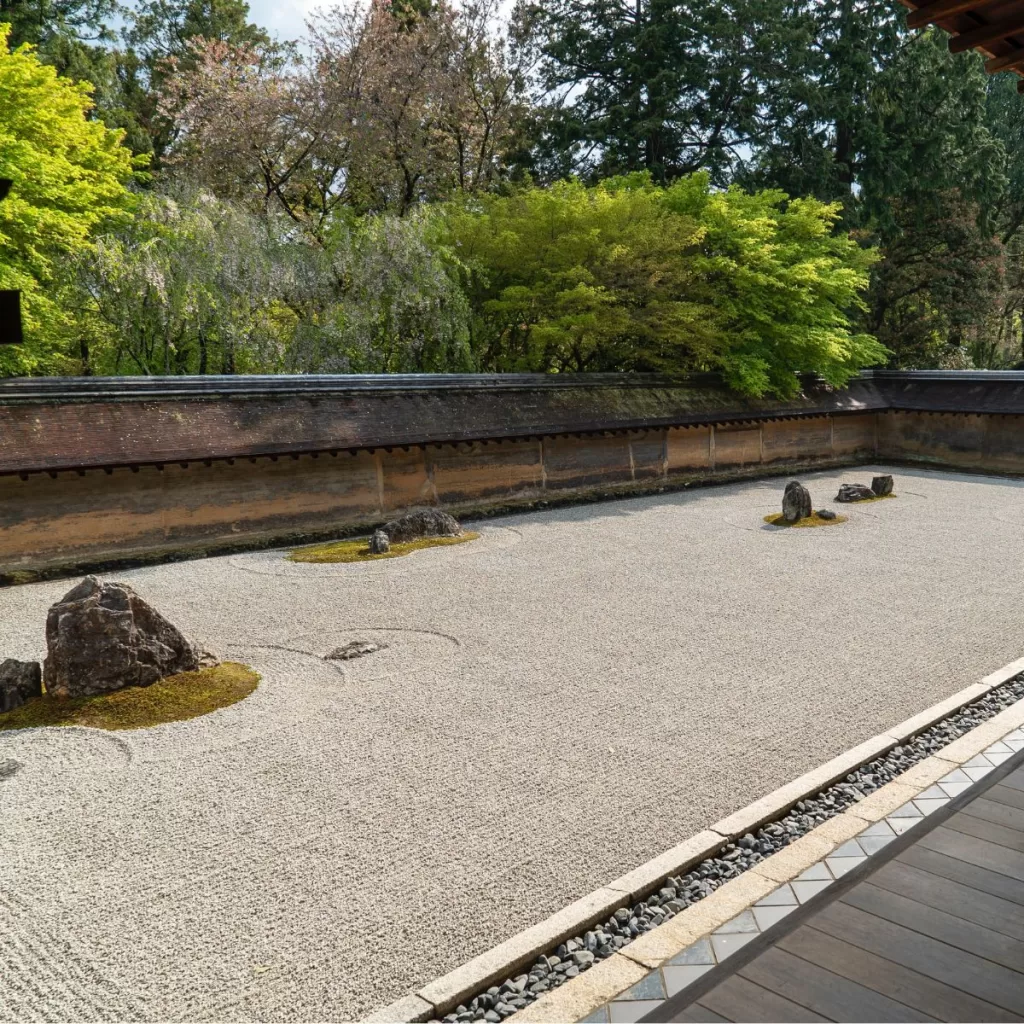
Ryoanji, one of the most important temples in Kyoto, is a place of tranquility and contemplation. This renowned Zen Buddhist temple invites visitors to experience the beauty of its iconic rock garden and immerse themselves in the peaceful atmosphere. As you step into Ryoanji Temple, you’ll feel a sense of serenity that washes over you, creating a space for reflection and inner peace.
The main attraction of Ryoanji Temple is its world-famous rock garden, considered a masterpiece of Zen simplicity. The garden features 15 carefully arranged rocks surrounded by meticulously raked white gravel, symbolizing the harmony between the elements. Sit on the veranda and admire the garden’s minimalist design, allowing your thoughts to settle and your mind to find stillness.
Don’t miss the opportunity to participate in Zen meditation sessions offered at Ryoanji Temple. Guided by experienced monks, these sessions allow visitors to delve deeper into the practice of mindfulness and find a sense of calm and clarity.
Tōji Temple
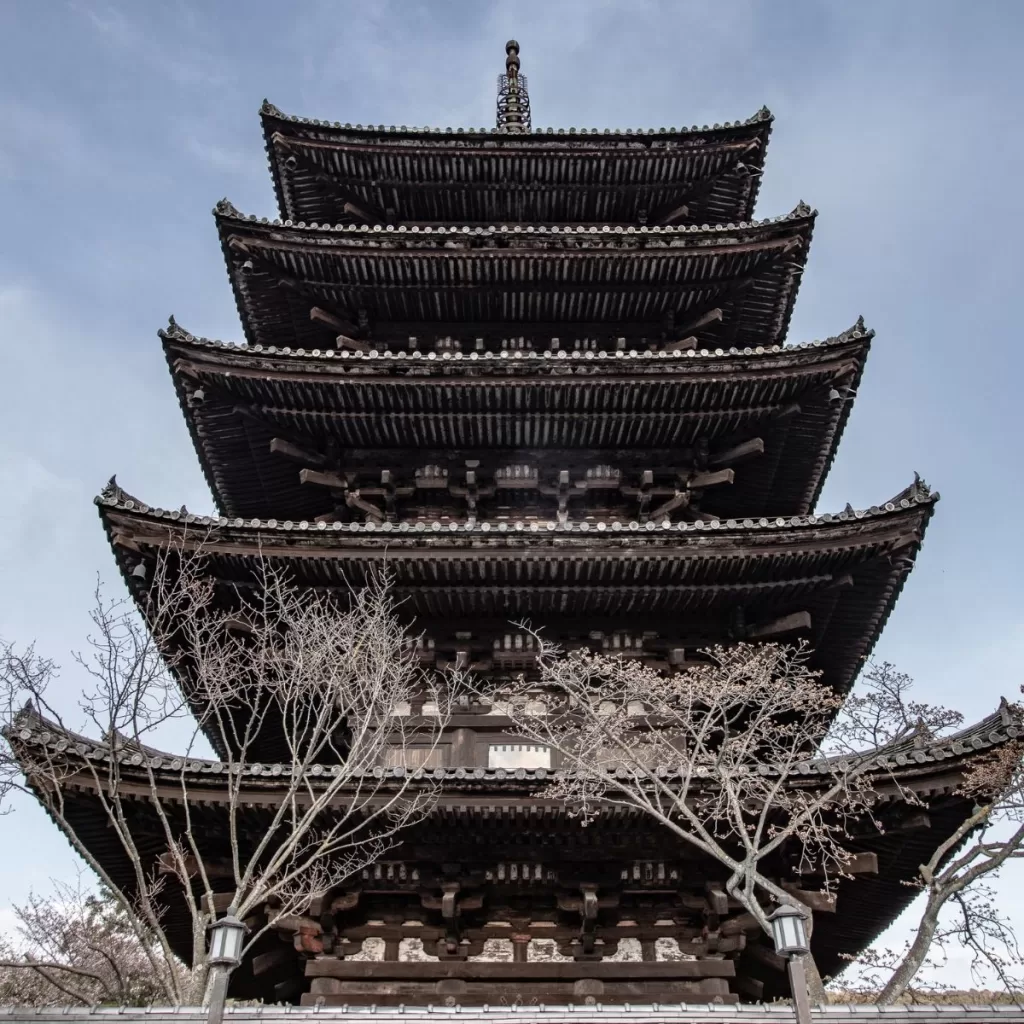
This historic temple, which is one of the favorite temples in Kyoto, showcases stunning architecture, rich cultural heritage, and offers visitors a unique glimpse into the ancient traditions of Japan. As you enter Tōji Temple, you’ll be captivated by its grandeur and the sense of reverence that fills the air.
One of the main attractions of Tōji Temple is its iconic five-story pagoda, which stands tall as a symbol of Japanese architectural excellence. Towering at over 57 meters, it is the tallest wooden pagoda in Japan. Marvel at the intricate details of the pagoda, with its elaborate carvings and vibrant colors that have stood the test of time. The pagoda offers a breathtaking sight that is sure to leave a lasting impression on visitors.
Explore the temple’s spacious grounds and discover various halls and buildings that showcase traditional Japanese architecture. Admire the impressive Great Buddha Hall, known as Kondo, which houses a remarkable statue of the Yakushi Nyorai, the Buddha of healing and medicine. Experience a sense of awe as you stand before this magnificent statue and appreciate the spiritual significance it holds.
Hōkan-ji Temple
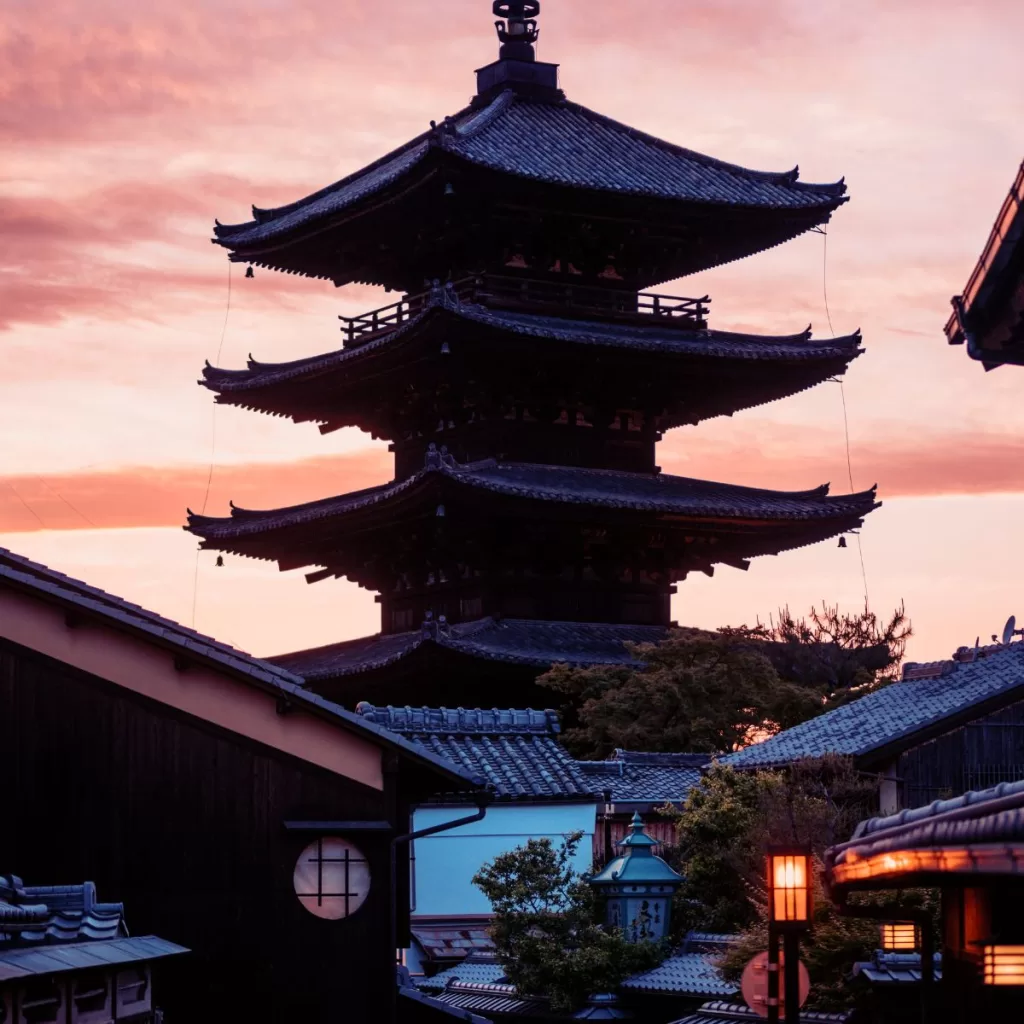
One of the main highlights of Hōkan-ji Temple is its stunning five-story pagoda, known as Yasaka Pagoda. This striking architectural masterpiece stands tall amidst the temple grounds and offers a magnificent view of Kyoto’s skyline. Take a moment to admire the intricate details and craftsmanship of this iconic structure and appreciate its harmonious blend of beauty and spirituality.
Hōkan-ji Temple is also home to numerous Buddhist statues and artwork that offer visitors a glimpse into the rich heritage and symbolism of Buddhism. Take the time to observe these intricate sculptures and learn about their spiritual significance.
Immerse yourself in the teachings of Buddhism and find inspiration in the timeless wisdom they convey.
Sanjusangendo Temple
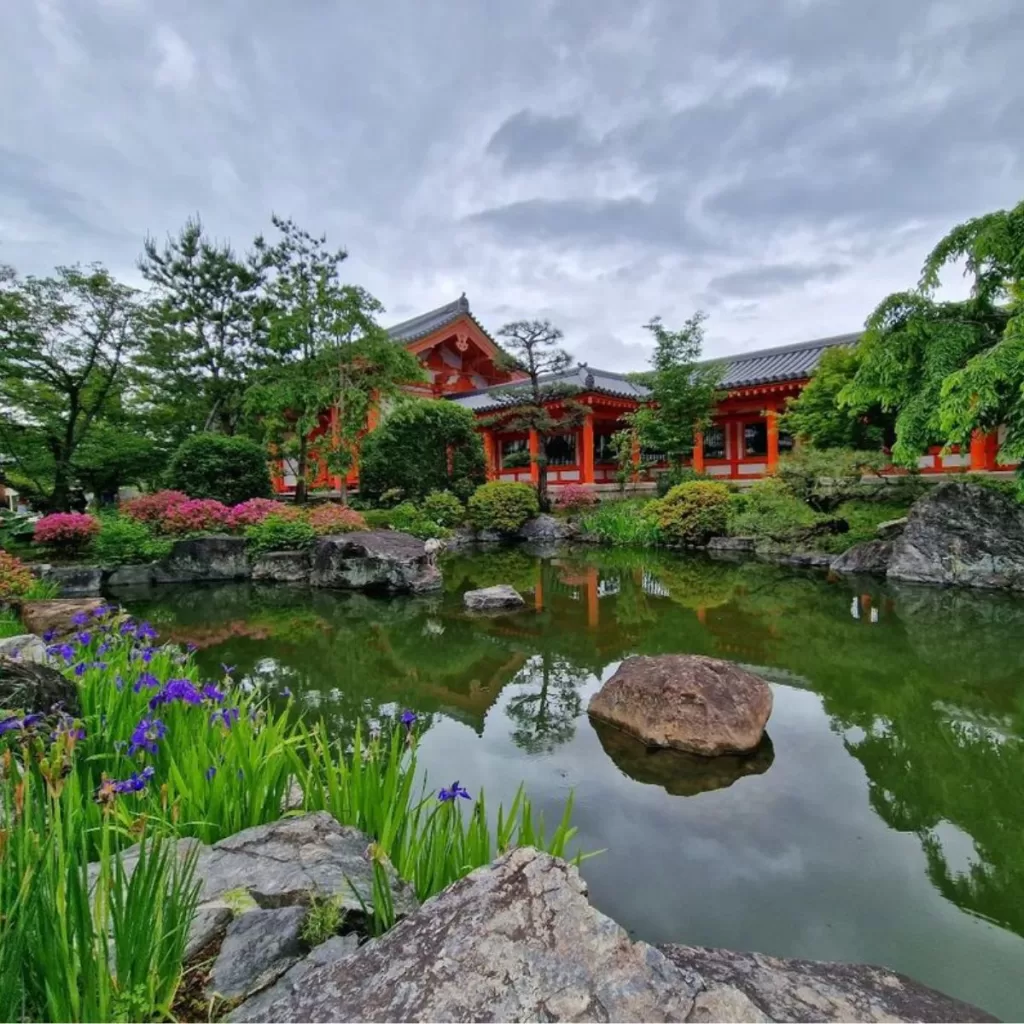
This awe-inspiring temple invites visitors to witness its breathtaking architecture, explore its captivating exhibits, and experience the spiritual ambiance that fills its halls. As you enter Sanjusangendo Temple, you’ll be mesmerized by its grandeur and beauty.
One of the main attractions of Sanjusangendo Temple is its massive main hall, which houses a collection of 1,001 life-sized statues of the Buddhist deity Avalokiteshvara. These statues stand in perfect alignment, creating a mesmerizing sight that is both awe-inspiring and humbling.
Take a moment to appreciate the intricate details of each statue and feel the sense of serenity that emanates from this sacred space.
Myoshin-ji Temple
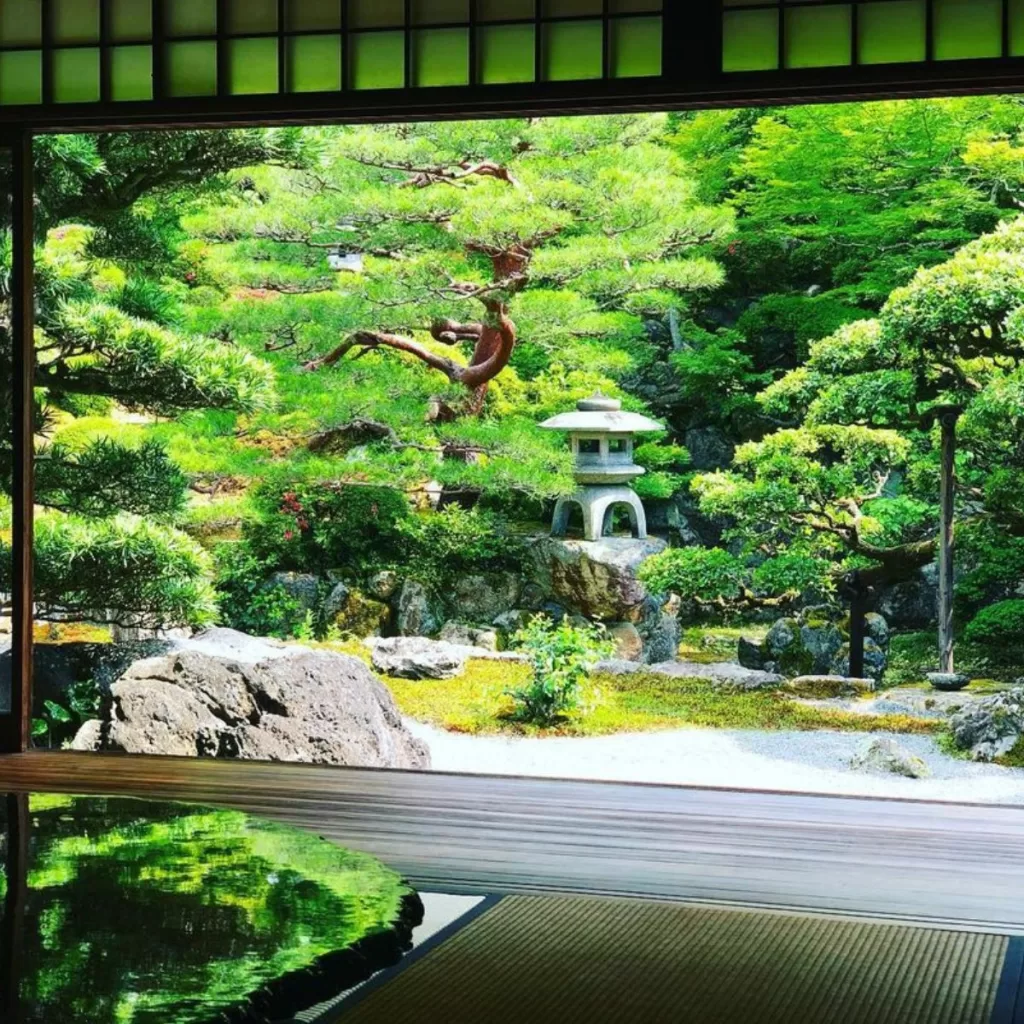
Myoshin-ji Temple is a peaceful and serene place of worship located in Kyoto, Japan. This hidden gem invites visitors to immerse themselves in its tranquil atmosphere, explore its beautiful gardens, and experience the rich spiritual traditions of Japan. As you enter Myoshin-ji Temple, you’ll feel a sense of calm and tranquility that welcomes you with open arms. This temple Kyoto is one of the best places to visit.
One of the main attractions of Myoshin-ji Temple is its stunning Zen garden, known as Taizoin Temple. This meticulously designed garden features meticulously raked gravel, carefully placed rocks, and lush foliage that creates a serene and meditative ambiance. Take a moment to sit and contemplate in this tranquil setting, allowing your mind to find stillness and peace.
Manpuku-ji Temple
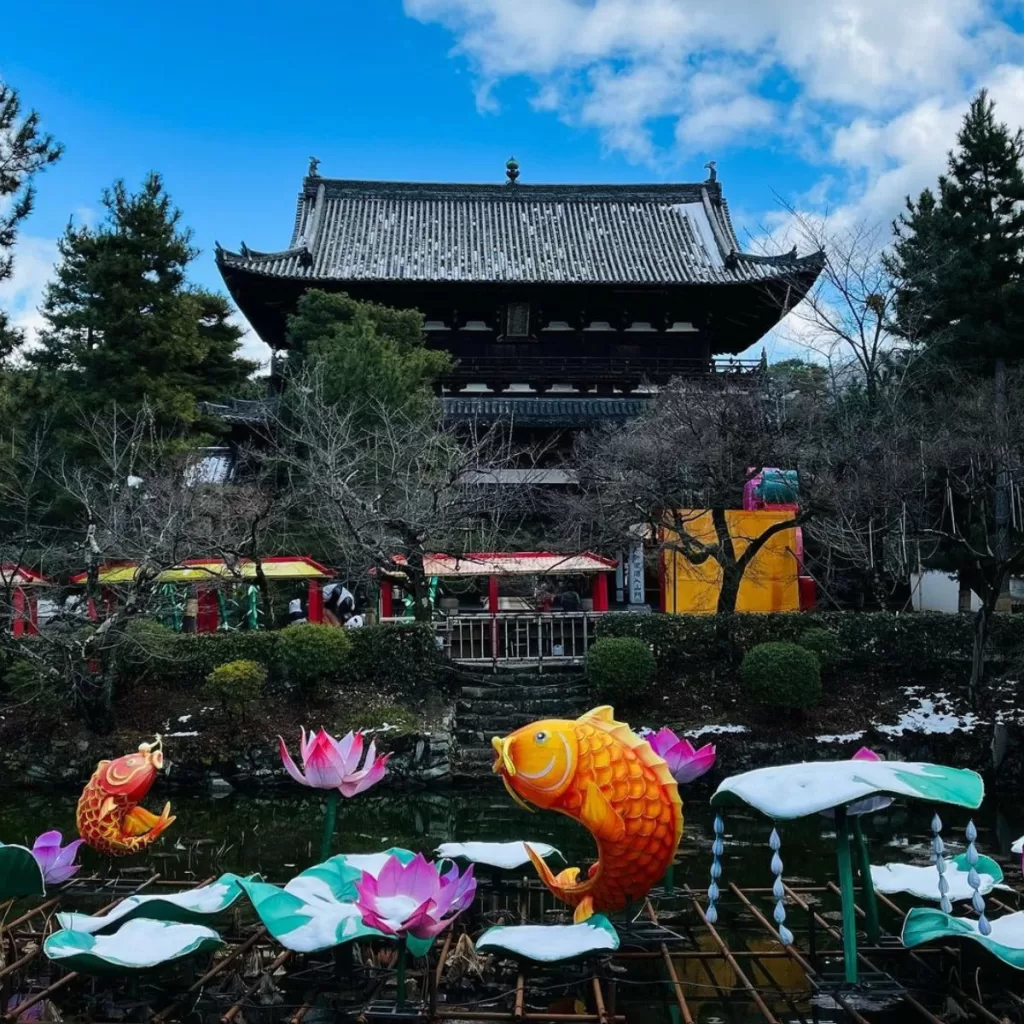
As you step into Manpuku-ji Temple, you’ll feel a sense of calm and serenity that envelops the whole environment.
One of the highlights of Manpuku-ji Temple is its magnificent main hall, known as Hatto. This impressive structure features intricate wooden carvings, traditional sliding doors, and a serene atmosphere that invites visitors to find inner peace. Step inside the hall and witness the beautiful altar where monks conduct their daily prayers, offering a glimpse into the deep spiritual practices of Zen Buddhism.
Manpuku-ji Temple offers visitors the chance to engage in Zen meditation and experience the transformative power of mindfulness and self-reflection. Guided by experienced monks, participants can join meditation sessions to focus their minds, find inner balance, and cultivate a deeper awareness of the present moment. Immerse yourself in the Zen practice and discover a peaceful haven within yourself.